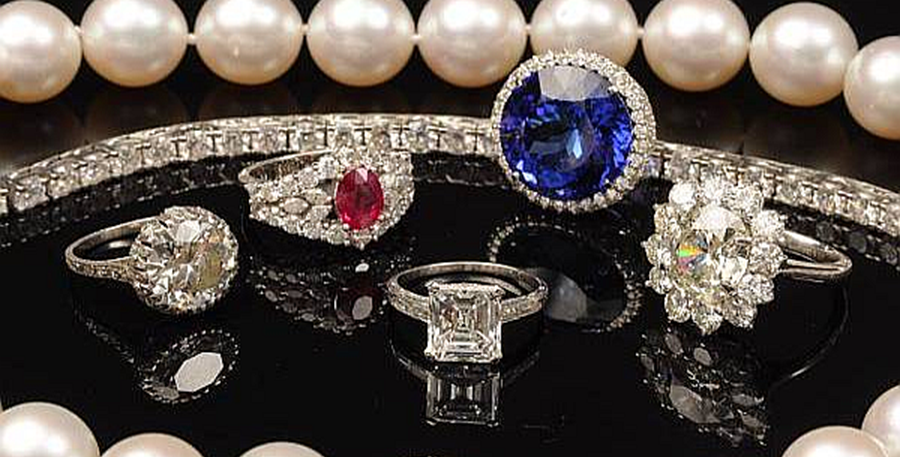Revealing the Rich Background Behind Exquisite Estate Precious Jewelry Pieces
The expedition of beautiful estate fashion jewelry pieces unveils an abundant tapestry of background, showing the societal worths and imaginative movements of their time. As we take a look at the elaborate information and provenance of these items, one must think about the extensive tales they hold-- tales that might test our understanding of beauty and significance in the world of fashion jewelry.
The Origins of Estate Precious Jewelry
The beginnings of estate precious jewelry can be mapped back a number of centuries, reflecting a rich tapestry of social and historic influences. Fashion jewelry served as a symbol of wealth and status amongst aristocrats and nobility. As different civilizations arised, one-of-a-kind designs and methods advanced, commonly linked with the customs and ideas of their respective societies.

As cultures advanced, estate precious jewelry began to represent greater than mere adornment; it became a form of individual expression, with items commonly gave with generations. This transfer of ownership imbued each thing with tales and memories, additionally improving its value. Hence, estate precious jewelry includes a myriad of influences, encapsulating the significance of human experience, creativity, and history, making it a significant facet of the fashion jewelry world today.

Remarkable Historical Periods
Throughout background, various ages have actually significantly influenced the layout and significance of estate fashion jewelry. Each duration brought forth unique designs, materials, and cultural contexts that shaped the creativity of jewelry-making.
The Victorian period (1837-1901) noted an extensive shift in jewelry style, defined by enchanting concepts and intricate craftsmanship. During this time around, fashion jewelry usually symbolized personal sentiment and was frequently utilized to honor substantial life occasions. The Art Nouveau activity (1890-1910) adhered to, stressing natural kinds and flowing lines, drawing inspiration from nature and the human figure.
The Roaring Twenties proclaimed the Art Deco duration (1920-1939), renowned for its geometric forms, vibrant shades, and a feeling of modernity. This age showed the enthusiasm of allure Age and the wish for luxury and opulence. Following The Second World War, the Mid-Century Modern period (1945-1960) welcomed simplicity and performance, showcasing clean lines and cutting-edge products.
Each of these historical eras has left an enduring mark on estate fashion jewelry, not only in terms of visual allure however also in the means these pieces reflect the social worths and technological developments of their time.
Iconic Design Features
Usually, famous style qualities of estate jewelry disclose a rich tapestry of social influences and imaginative motions. estate jewelry for sale. Each item works as an aesthetic narrative, showcasing the stylistic choices of its age and the artisans' proficiency. For instance, the detailed fretwork job typical in Victorian jewelry exhibits the period's attraction with nature and love, commonly incorporating concepts such as flowers and leaves.
The Art Nouveau movement introduced flowing lines and natural types, emphasizing the elegance of natural environments. In contrast, the strong geometric patterns of Art Deco fashion jewelry reflect the modernist principles of the 1920s, identified by balance and a concentrate on commercial content materials.
Furthermore, using dynamic gems and cutting-edge techniques, such as enameling and pavé setups, even more differentiates these items. Shade palettes usually correspond to particular social contexts, with particular rocks signifying wide range or status.
Famous Estate Jewelry Pieces
Estate fashion jewelry includes a selection of prominent items that have transcended time, each telling a distinct story of its origin. Among these, the "Napoleon Diamond Pendant," originally crafted for Empress Josephine, exemplifies opulence with its complex style and historic relevance. An additional famous item is the "Cartier Panther Arm Band," which showcases the famous panther concept that has actually come to be identified with the Cartier name, mixing virtuosity with a vibrant declaration.
The "Bulgari Serpenti" collection, with its sinuous, snake-inspired designs, has captivated collectors because the mid-20th century, representing high-end and appeal. In addition, the "Maharaja Necklace," decorated with a fascinating selection of gemstones, reflects the grandeur of Indian royalty and the rich cultural heritage related to estate jewelry.

The Worth of Provenance
Provenance plays an essential duty in identifying the worth of estate precious jewelry, as it provides a documented history that improves the item's significance and value. A product with a well-documented family tree frequently commands higher costs because of its organization with noticeable numbers, historic events, or creative movements. Collection agencies and financiers alike are drawn to items that tell a story, as these stories include layers of implying past plain aesthetics.
The confirmation of provenance can include various kinds of documentation, such as initial find this acquisition invoices, evaluations, and event documents. Additionally, narrative histories gave through family members can add to the story, boosting the appeal of the fashion jewelry (estate jewelry). The even more reliable and in-depth the provenance, the most likely it is to stand out on the market
Additionally, provenance can mitigate problems relating to authenticity; things with recognized backgrounds are much less likely to be checked out as reproductions or counterfeits. By doing this, provenance not just raises the intrinsic worth of estate jewelry yet also safeguards the enthusiast's investment. Inevitably, a compelling provenance changes a piece from a simple things into a valued artifact of background, making it a sought after enhancement to any collection.
Final Thought
The exploration of estate fashion jewelry discloses a profound link in between artistry and historic context. Each item functions as a testimony to the workmanship and cultural impacts of its time, mirroring the developing preferences and values of society. The relevance of provenance further improves the attraction of these prizes, transforming them right into valued heirlooms. Eventually, the abundant narratives behind estate fashion jewelry not just celebrate specific artistry but likewise envelop the broader tapestry of human history and social development.